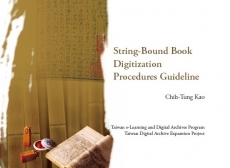TELDAP Collections
| String-Bound Book Digitization Procedures Guideline |
|
The “string-bound ancient books” referred to in the guideline are hand-written or printed books dated before 1911. Since these books are made of paper and string, they can easily be damaged and embrittled by natural disasters or over usage. It is all the more important to digitize them. By analyzing and sorting out the digitization procedures of the string-bound books of the National Palace Museum, National Central Library, Academia Sinica Institute of History and Philology Fu Ssu Nien Library, and National Taiwan University Library, the guideline provides rules and reference standards to institutions which wish to digitize the same kinds of books. The content includes units of digitization work flowchart, preliminary operations, object digitization procedure, metadata and database establishment, etc. It is hoped that the guideline can provide readers with a complete concept of digital archives and a blueprint for planning digitization work on ancient string-bound books.
|













